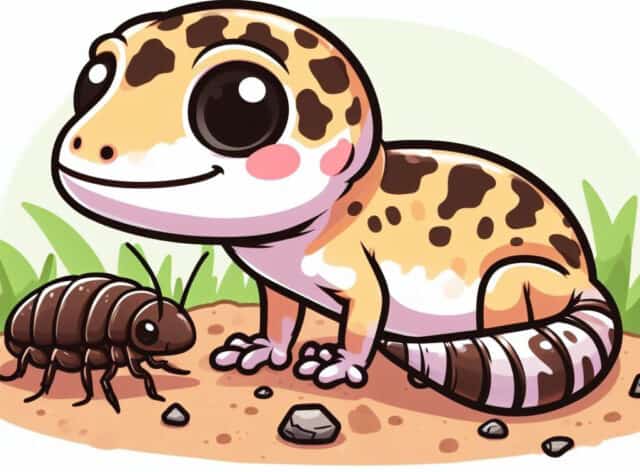Taking care of a baby leopard gecko is a task that requires understanding and patience. These little reptiles have specific needs, much like any other pet.
To keep them healthy, it’s important to replicate their natural environment and meet their dietary and habitat needs. This means setting up the right living space, feeding them the right foods, and handling them with care.
Essential Enclosure Components: Set up a secure habitat with hides, a water dish, and UVB lighting. Choose safe substrates like paper towels or non-glossy newspaper.
Dietary Needs: Feed them staple foods such as crickets, mealworms, and Dubai roaches. Remember, treats like silkworms and waxworms should be given in moderation.
Calcium & Supplements: Address potential calcium deficiencies by dusting their food with calcium powder and gut loading crickets. This prevents conditions like metabolic bone disease.
Fresh Water: Always have a shallow dish with clean water available in their enclosure. Change this water regularly to prevent dehydration.
Handling & Interaction: Before handling, allow them time to adjust and gain trust. Observe recommended handling frequencies and be gentle to reduce stress.
Baby Leopard Gecko Care: What Do They Need To Thrive?
When you’re responsible for a baby leopard gecko, it’s like taking a tiny slice of the desert and bringing it into your home. Let’s explore what these fascinating creatures need to grow strong and healthy. Breeding Leos them is just the start, and there is a long road ahead of you once that initial part is done.
Essential Needs: Baby leopard geckos have several fundamental needs. These include:
- A suitable habitat
- Proper nutrition
- Fresh water
- Gentle handling and interaction
Ensuring these needs are met will help your baby gecko thrive and grow into a healthy adult.
Habitat: The environment you provide should resemble their natural desert surroundings. This doesn’t mean just sand and a few rocks. It means ensuring the temperature is correct, there’s a place for them to hide, and the humidity is on point. Mimicking their natural habitat helps reduce stress and promotes natural behavior.
Nutrition: Your baby leopard gecko’s diet is crucial. In the wild, they consume a variety of insects. So, replicating this varied diet at home is essential. It’s not just about giving them food but also ensuring they get the right supplements. For instance, baby leopard geckos need a good balance of vitamins and minerals, which can be provided through proper supplementation.
Fresh Water: It might surprise you, but fresh water availability is vital. Even in the desert, these creatures find pockets of moisture and dew. A shallow dish of clean water in their enclosure keeps them hydrated. Remember, dehydration can lead to health issues.
Handling: Last but not least, how you handle and interact with your baby gecko makes a world of difference. They’re not toys, so gentle and appropriate handling is crucial. Over time, regular and kind interaction helps build trust, making them more receptive to being handled.
How To Set Up an Enclosure For a Baby Leopard Gecko
Setting up an enclosure for a baby leopard gecko isn’t just about placing them in a tank and calling it a day. It’s about creating a secure and stimulating environment that mirrors their natural habitat. Let’s break down the steps and components you need to make their space perfect.
Steps to Set Up the Enclosure:
- Choose the Right Enclosure Size: Start with a tank or terrarium that’s at least 10 gallons for a baby gecko. This provides ample space for them to move, explore, and grow.
- Add Safe Substrates: Use safe substrates like paper towels, non-glossy newspaper, or tile. These are easy to clean and reduce the risk of impaction if accidentally ingested.
- Place Hides and Decor: Add multiple hides for your gecko to take refuge in. These can be commercially bought or DIY, using items like overturned plant pots. Decorate the enclosure with rocks, logs, and non-toxic plants to create a stimulating environment.
- Install UVB Lighting and Heating: Provide UVB lighting using special reptile bulbs. This helps in synthesizing vitamin D3, which is essential for calcium absorption. Additionally, leopard geckos are ectothermic, meaning they rely on external sources for heat. Ensure you have a heating pad or ceramic heat emitter to maintain a temperature gradient in the enclosure.
- Water and Food Dishes: Place a shallow water dish with fresh water, ensuring it’s always clean. Also, have a separate dish for food.
Ensure the top of the enclosure has a securely-locking lid. Baby leopard geckos are curious creatures and might try to venture out, so it’s essential to keep them safe from potential hazards.
What Should You Feed a Baby Leopard Gecko
Nourishing a baby leopard gecko involves more than just offering any insect you find. Their dietary needs are specific, aiming to foster growth and ensure overall health.
Staple Foods for Baby Leopard Geckos
When it comes to the daily diet of baby leopard geckos, certain insects are more favorable than others. The primary staple foods for these geckos are crickets, mealworms, and Dubai roaches. These bugs provide essential nutrients and are easy for the baby geckos to digest.
While the main staples are crucial, variety is also essential. You can introduce other insects like silkworms, hornworms, waxworms, butterworms, and superworms. However, consider these as special treats. They have a higher fat content, which can be beneficial for growth but should be given in moderation to prevent obesity and other health issues.
Calcium Deficiencies and Vitamin Supplements
Calcium plays an integral role in the growth and health of baby leopard geckos. A lack of it can lead to serious health concerns, making it crucial for pet owners to be vigilant about their gecko’s calcium intake. So, why are calcium deficiencies such a pressing matter for these little creatures, and how can we combat them?
For starters, calcium is pivotal for bone formation and strength. Without adequate calcium, baby leopard geckos can suffer from metabolic bone disease, a painful condition where their bones become weak, fragile, and deformed. This disease can severely impact their quality of life and, in the worst cases, can be fatal.
To prevent this, many reptile enthusiasts turn to vitamin supplements. There are two primary techniques to ensure your gecko is getting the calcium they need:
Dusting: This involves lightly coating the insects (like crickets or mealworms) with a calcium powder before offering them to your gecko. The gecko then consumes the calcium along with their food, integrating it directly into their diet.
Gut Loading: This method is a bit more indirect. It involves feeding the crickets or other insects a high-calcium meal before they’re consumed by the gecko. When the gecko eats the insect, they also ingest the calcium-rich contents of the insect’s gut.
Fresh Water Availability
Water isn’t just essential for humans—it’s crucial for our reptilian friends as well. Ensuring fresh water accessibility for your baby leopard gecko is a cornerstone of proper care. While these desert natives might not drink as frequently as other pets, the water they consume plays a vital role in their health and hydration.
Setting up a water source for your gecko is straightforward. Use a shallow dish that’s easy for them to access without the risk of drowning. Place this dish in a stable part of their enclosure, ensuring it doesn’t get tipped over by the gecko’s movements. It’s essential to fill this dish with clean water, free from contaminants.
Now, merely having a water dish isn’t enough. Regular water changes are imperative to ensure the water remains clean and free from bacteria or other potential contaminants. A daily check and refill, combined with a thorough cleaning of the dish every few days, should become part of your routine.
How to Handle and Interact With a Baby Leo
As you embark on your journey with your baby leopard gecko, building a bond of trust and understanding is paramount. Interacting with your “Baby Leo” isn’t just about handling; it’s about forming a connection that benefits both you and your tiny reptilian friend. But as with all things new, there’s a learning curve.
How to Handle a Baby Leopard Gecko Properly
Handling any creature, especially one as delicate as a baby leopard gecko, requires patience, care, and understanding. To handle a baby leopard gecko properly, it’s vital to approach them slowly and gently. Swift movements or a tight grip can cause undue stress and even physical harm.
Before regular handling commences, it’s essential to give them time to adjust and gain trust. Initially, your gecko might be skittish, hiding when you approach or even trying to escape. It’s a natural defense mechanism. To mitigate this, begin with short sessions where you place your hand inside their enclosure without trying to touch them. This allows them to familiarize themselves with your scent and presence.
For those particularly skittish geckos, a few additional tips can make a world of difference:
- Avoid handling during their shedding period.
- Ensure your hands are warm, not cold.
- Approach them from the front rather than from above, so you don’t resemble a predator.
As for the recommended handling frequency, it’s best to start with short sessions, around 5 minutes, every other day. Gradually increase this time as they become more comfortable with you.
Benefits of Interaction with Adult Leopard Geckos
Interactions between baby and adult leopard geckos can offer a plethora of benefits, especially when handled with care and consideration. One of the most significant advantages of such interactions is the enhancement of socialization and well-being for the younger geckos. By observing and interacting with their mature counterparts, baby leopard geckos can pick up essential life skills more rapidly.
For instance, a baby gecko can learn vital hunting and feeding behaviors by watching an adult in action. This mimicry allows the younger gecko to refine its techniques, ensuring it gets the nourishment it needs. Think of it as a form of on-the-job training, but for geckos!
However, it’s not all smooth sailing. There are potential risks involved. Adult geckos, especially in unfamiliar settings or with unfamiliar geckos, might become territorial or aggressive. To mitigate these risks, it’s crucial to introduce them to each other gradually. Start by placing their enclosures next to each other for a few days so they can get used to each other’s presence. Next, allow supervised face-to-face interactions in a neutral setting, outside their enclosures. Always monitor their body language and separate them at the first sign of stress or aggression.
Signs That The Baby Leopard Gecko Is Sick & What To Do
When caring for a baby leopard gecko, understanding the signs of potential illness can make a significant difference in ensuring their well-being. Early detection and intervention can prevent minor health concerns from escalating into severe, sometimes life-threatening conditions. Here’s what you need to look out for and the steps to take if you suspect your gecko might be unwell.
1. Calcium Deficiencies and Metabolic Bone Disease (MBD): This is one of the most common health issues in geckos, marked by soft or deformed bones, lethargy, or tremors. The legs might appear swollen or bent, and the jaw might seem soft or misaligned. These symptoms indicate a severe deficiency in calcium, which can lead to MBD if left untreated.
2. Gastrointestinal Impaction: This condition occurs when a gecko ingests something it cannot digest, like certain substrates or large food items. Symptoms include a swollen belly, loss of appetite, and difficulty or lack of defecation.
3. Retention of Shedding Skin: While shedding is a natural process, sometimes, baby geckos can retain bits of old skin, especially around their toes, tail, or eyes. If not removed, this can lead to complications such as infections or loss of digits.
If you observe any of these signs of illness in your baby leopard gecko, it is crucial to take action immediately. Do not attempt to self-diagnose or treat these symptoms at home. Instead, consult with a specialized reptile veterinarian as soon as possible.


